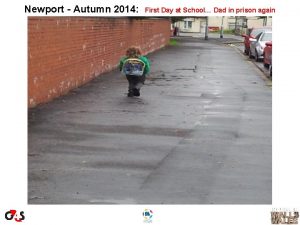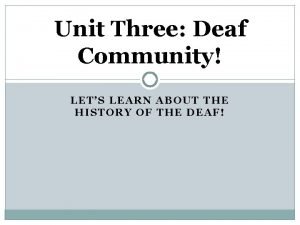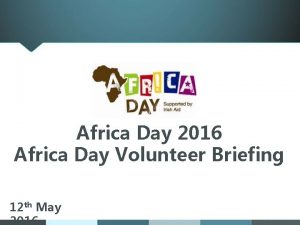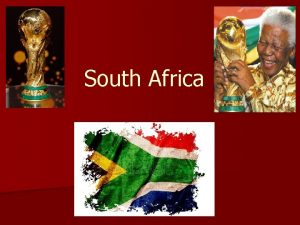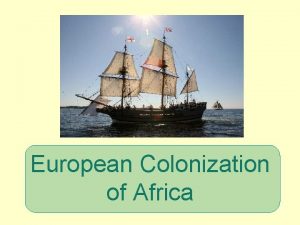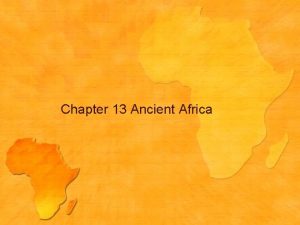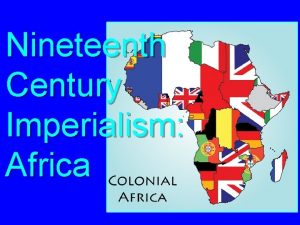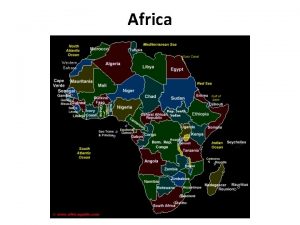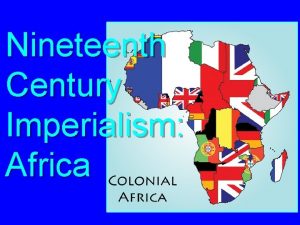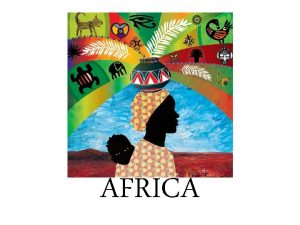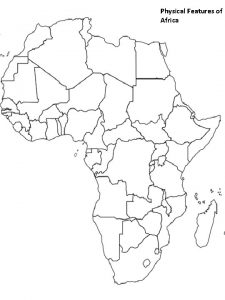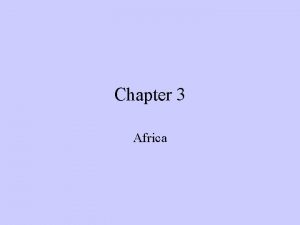WELCOME FAMILY FUN DAY 2014 Welcome to Africa

































- Slides: 33

WELCOME FAMILY FUN DAY 2014

Welcome to Africa in its goodness is a beautiful place with different people traditions and culture. Though there are many similarities its the differences that make Africa so unique and wonderful. There are over 3000 languages spoken. There are many different ethnicities. The terrain ranges from large expanses of sandy desserts to snow peaked mountains.

Asante Royals Asante royals in their rich cloths, drawing their cloth lower as a sign of reverence and time-honored customs when addressing Ote kokooso (Occupant of the Golden stool), Asantehene (King of the Asantes) Nana Otumfuo Osei Tutu II Source: Trip. Down. Memory. Lane

Fabrics West African fabric has different kinds of designs and patterns. Much of the beauty of fabric is because of the method used to make it. Probably the most popular West African fabric is Kente, from Ghana.

Efik men from Calabar, Nigeria Procession of Efik men from Calabar in Nigeria in their impressive and traditional dressing style during Carnival. The Efik are an ethnic group located in southeastern Nigeria. Source : Trip. Down. Memory. Lane

KENTE q q q The Kente cloth is iconic because it is a kind of woven fabric that is recognised as coming from Africa through out the world and is known for its vibrant colours and geometric shapes. As it is the tradition he is wearing yellow which in Ghanaian tradition is a symbol of royalty and power and is worn by people of high status and influence. The making of Kente is very unique and takes a lot of space and is carefully set out to avoid knots or mistakes being made. This is a picture of Bill Clinton, Hilary Clinton and Jerry J Rawlings in 1998

Modern African Fashion Source: African. Fashion. Inspiration

Modern African Fashion Source: African. Fashion. Inspiration

Akan couple from Ghana in their Kente cloth during their traditional wedding ceremony at Accra, Ghana Source: African. Fashion. Inspiration

Modern African Fashion Source: African. Fashion. Inspiration

Adire is a popular style of making clothes in West Africa particularly Ivory Coast, Gambia and Nigeria. ‘Adire’ is the Yoruba word for tie and dye and has the literal meaning is tie and soak. There are many ways to make adire, it is not always tied sometimes wax, starch paste or clamping is used instead of a string or wire to tie the material. The technique of tying is used to create a symmetrical design which is how all adire used to be. Source: African. Fashion. Inspiration

Ankara is another type of fabric popular in West Africa. However in spite of popular belief it is of European origin. It was originally intended for the Indonesian market but was adopted by Africa and has since been adapted and recognised as African print. Ankara represents the culture and lifestyle of the West African people and has gained much popularity and an identity as an African fabric.

Coral Beads They may be used as fashion now but there was a time when they had great meaning and value. Corals are obtained from the bottom of the sea - mined from coral stones and made into jewellery. Coral has a hard core that can be polished to bring out a red, rose or pink colour. They are usually worn in the delta state, in Nigeria to show a high social status. Indeed coral was once worn only by royalty and the very rich. Nowadays in some celebrations such as weddings, depending on the part of Nigeria they are from, the celebrants of the day may wear them.

African Head Wrap

Himba Girl, Namibia Beautiful and smiling Himba girl from Epuwa, Kaokoland in Namibia with her traditional two plaited (braid) hairstyle showing that she is virgin and yet to hit puberty. Source: Trip. Down. Memory. Lane

Ko Woman, Burkina Faso Ethnic Ko (Kolsi) woman from Southern Burkina Faso with her awesome tribal facial marks, that identify her as Ko woman from the larger Gurunsi ethnic group of Ghana and Burkina Faso in West Africa. Source: African. Fashion. Inspiration

Nzema Woman, Ivory Coast Nzema woman from Grand Bassam in Ivory Coast (Cote d`Ivoire), West Africa sitting majestically in her palanquin carried by strong men, as she dance with her bodua (animal tail) during the procession of Kings and Queens at the celebration of Nzema Abissa Festival at Grand Bassam. Nzema people also known as Ndenye are descendants of the Akan people in Ghana. Source: African. Fashion. Inspiration

Krobo Girls, Ghana Krobo girls from Somanya in the Eastern Region of Ghana in their Dipo (puberty) initiation outfit adorned in layers of glass beads and swathed in lengths of printed and hand woven fabrics sitting down and waiting to perform traditional klama dance. Their dressing shows that they have completed their Dipo (puberty) out-dooring ceremony and their initiation into womanhood.

Mami Wata (Water Goddess) Sand shells drawing of Mami Wata at Festival Of Black Deities tripdownmemorylane. blogspot. co. uk

Peggy & Joe Appiah (aka Abaaba s 3), the legendary Ghanaian lawyer, maverick Nationalist leader and one of the fighters of Ghana`s independence with his British aristocratic wife Peggy Appiah (Enid Margaret Cripps), the youngest daughter of Labour politician and former chancellor of Exchequer Sir Stafford Cripps. Source: Trip. Down. Memory. Lane

African Food This is Yam pottage from Nigeria. This is known as asaro in Yoruba. Ghanaian style boiled yam, with garden egg and Ghanaian cooked stew. This is a yam used in a different way, this is yam balls from Senegal.

YAM Yam is a very popular crop in West Africa. It takes an enormous amount of time and labour to plant. In igboland in Nigeria it is considered the ‘king of crops’, because traditionally it was used as a measure of wealth. It is celebrated in Igboland, at the breaking of the new harvest, this is known as Iwa Ji. The yam is shared and a big thanksgiving is held. Traditionally, the king would be the first to eat then offer thanks to the gods because the Igbos believe that king is the intermediary between gods and the people. Yam is often used in general cultural celebrations because of the effort and time it takes to prepare. Igbo people also present yam at ceremonies such as weddings as it traditionally indicates wealth.

West Africans have a diet filled with mostly rice, plantain, starchy based foods such as fufu and pounded yam. These foods are normally accompanied by a tomato based soup or stew. However, in many cultures the groundnut is just as important as the tomato There is also a common sauce in West Africa with a peanut base that has been ‘re mixed’ in many West African cultures many countries. There are many variations, has many different names and is eaten all over West Africa. Groundnut a very valued crop in West Africa This is a plate of rice adorned with groundnut stew (peanut soup)

PALM KERNEL The palm kernel is the edible seed of the oil palm tree. The fruit yields two distinct oils—palm oil derived from the outer parts of the fruit, and palm kernel oil derived from the kernel. Source: wikipedia

PALM KERNEL& WWII British Empire palm kernel propaganda: the first image is a fulllength depiction of an African man climbing a tree to collect palm kernels. The second image shows two African women and a child sorting the kernels. The third image depicts a worker standing beside an industrial foodproduction machine. The final image illustrates three British infantrymen, seated near a battlefield, eating biscuits. Source: wikipedia

Peanut Stew This is fish being cooked, that is usually cooked with peanut oil in Ivory Coast to give a unique taste to the fish. This is cassava leaf stew complimented with rice. This stew is prepared in Sierra Leone with groundnut to give it that West African flavour.

Karo Girls, Ethiopia Karo girl from Omo valley in Ethiopia painting face and dressing the hair of her sister lying on the ground with red ochre clay to make her beautiful so that she can attract an attention of a potential suitor at an occasion in their village. Source (picture): Trip. Down. Memory. Lane

Rwandan Bride BEAUTIFUL Rwandan bride (sitting in the middle, with two small sticks tied to her hair as a symbol of marriage) and her equally beautiful bridesmaids at a traditional wedding at Kigali in Rwanda, Central Africa. Source (picture): Trip. Down. Memory. Lane

Tiv Groom, Benue State, Nigeria Tiv groom from Benue State in Nigeria and his best men at a traditional wedding. The woven black and white shawl is a symbol of Tiv national identity. Source (picture): Trip. Down. Memory. Lane

Voodoo practitioners at Ekpe Festival Benin Republic Voodoo practitioners at Ekpe Festival at Ouidah, Benin. The Fon kingdom was located in what is now southern Benin, a region some anthropologists refer to as the "cradle of Voodoo. " People also practice Voodoo in Togo, Ghana and other countries in northwestern Africa. Approximately 30 million people in Togo, Ghana and Benin practice Voodoo today. Source: National Public Radio: Radio Expeditions

Sankofa Symbol The Sankofa symbol appears frequently in traditional Akan art and has also been adopted as an important symbol in an African American and African Diaspora context to represent ‘the need to reflect on the past to build a successful future’. Source: wikipedia

The Baobab Tree “Wisdom is like baobab tree. No one individual can embrace it. ” African Proverb

This is just a glimpse of Africa that offers an insight into a continent that is filled with a collection of people, cultures and traditions recognised as much for their differences as their similarities. Thank you for coming today!!!
 Day 1 day 2 day 3 day 4
Day 1 day 2 day 3 day 4 Day 1 day 2 day 817
Day 1 day 2 day 817 First day of autumn 2014
First day of autumn 2014 Welcome and have fun
Welcome and have fun Family fun time
Family fun time West african societies around 1492
West african societies around 1492 Schoolmax gradebook
Schoolmax gradebook Ocean the part day after day
Ocean the part day after day Day to day maintenance
Day to day maintenance As your room gets messier day by day, entropy is
As your room gets messier day by day, entropy is I don't know tomorrow
I don't know tomorrow Timeline of romeo and juliet act 1
Timeline of romeo and juliet act 1 Growing day by day
Growing day by day Seed germination inhibitors examples
Seed germination inhibitors examples Conclusion of seed germination
Conclusion of seed germination Observation of plant growth day by day
Observation of plant growth day by day I live for jesus day after day
I live for jesus day after day One day in heaven
One day in heaven Day one day one noodle ss2
Day one day one noodle ss2 Dayone ss2
Dayone ss2 Welcome to day 2
Welcome to day 2 Welcome back day 2
Welcome back day 2 Welcome on your first day
Welcome on your first day Welcome welcome this is our christmas story
Welcome welcome this is our christmas story Welcome new cub scout family
Welcome new cub scout family Difference between nuclear family and joint family
Difference between nuclear family and joint family Periodic table families
Periodic table families Binuclear family vs blended family
Binuclear family vs blended family Character sketch of tommy
Character sketch of tommy Fun facts about william shakespeare
Fun facts about william shakespeare I spy balloon popper
I spy balloon popper Fun facts about asl
Fun facts about asl Fun in the city unit 8
Fun in the city unit 8 Mirza denovan
Mirza denovan


